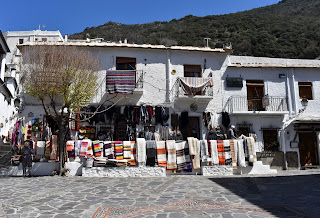 |
| Typical white village, Las Alpujarras |
 |
| Typical Alpujarran chimney |
 |
| More round Moorish chimneys |
 |
| Trevelez |
 |
| Loading hams onto a lorry, Trevelez |
 |
| Ham shop, Trevelez |
 |
| View up the Poquiera gorge from Pampaneira to Bubion and Capileira |
 |
| Pampaneira village square |
 |
| Pampaneira village square |
We continued along the winding mountainous road until we reached Pampaneira, one of a trio of picturesque whitewashed villages. It is the lowest of the three at just over 1000m and hugs the steep slopes of the Poqueira valley. We parked at the edge of the village and went in search of further refreshments. These villages were the last stronghold of the Moors. They have retained much of their traditional Berber architecture with lots of white sugar cube shaped houses, flat roofs and tall round chimney pots in evidence. Pampaneira was bustling with craft shops, cafes, hikers and the inevitable tourists. We found a pleasant cafe in the central square and the sun from where we could admire the local handicraft shops selling colourful coarsely-woven rugs as well as walkers returning from a hard day's hike in the mountains.


 |
| View down the Poqueira gorge from Capileira to Bubion and Pampaneira |
 |
| Capileira |
 |
| Capileira |
 |
| Capileira village square |
We returned to our car for the short final journey of the day up to Capileira, the highest, less touristy and possibly more authentic of the three villages, where we were booked into a Finca (country house hotel) for the night. The village is full of twisting, steep streets, springs gushing with fresh mountain water and there were superb views of the Poquiera valley, gorge and the snow capped Sierra Nevada mountains everywhere we looked. Capileira is also a good base for walking so having invested in some serious boots we asked our hotel if they could suggest a relatively easy local walk. We were given a map, told where to start and the following morning we set off up the gorge for a bit of an adventure. The walk took us up through steep, rocky scrubland and on to a lush river valley via an old abandoned village. We had wonderful views of the high peaks including Mulhacen, at 3479m the highest mountain in Spain. We walked passed acequias - ancient irrigation channels developed by the Moors and still in operation, swarms of colourful butterflies, hedgerows of wild herbs and all the while keeping a lookout for the elusive Golden Oriole.
 |
| Capileira |

Capileira |
| View of Sierra Nevada mountains at the start of our walk |
 |
| Riverside cafe Pinos Genil |
 |
| Pinos Genil |
 |
| What happened to the sun?! |
Next morning we looked out from our bedroom balcony overlooking the countryside and on to Granada twinkling in the far distance. Unfortunately it wasn't a pretty sight. The skies had turned dark and ominous. Our time away was short so we decided to continue as planned and set off in the car for Pradollano, the centre of the Sierra Nevada ski resort. As we climbed higher the visibility became almost non existent as the road was engulfed by the descending swirling clouds.
 |
| Pradollano |
 |
| Pradollano |
 |
| Pradollano ski slopes |
 |
| Guejar Sierra and the Canales reservoir |
 |
| Raining goats and dogs! |
 |
| Pinos Genil |







Absolutely loved reading this blog, it sounds like, for the most part, that you had a fab time, just sorry we weren't around to join in!.
ReplyDeleteHope to see you before we depart for the summer on the 24th of this month!
LOL C & D xxx
Thanks guys. Shame you couldn't join us! x
Delete